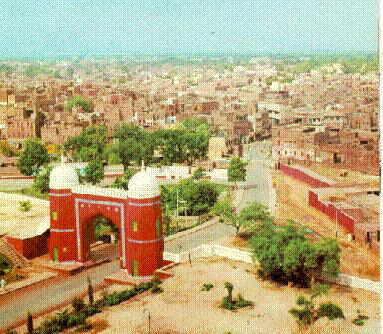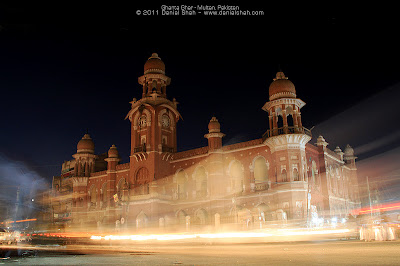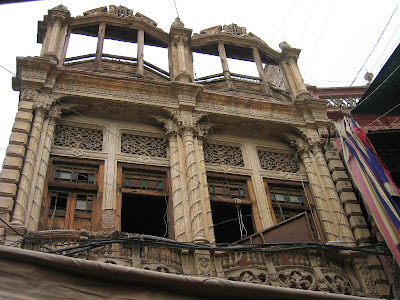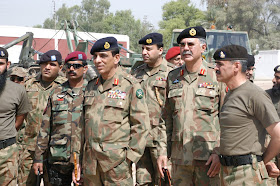




MULTAN, LAND OF SAINTS, PUNJAB, PAKISTAN
Multan (help·info) (Punjabi/Urdu: مُلتان), Multān City is a city in the Punjab Province of Pakistan and capital of Multan District. It is located in the southern part of the province on the east bank of the Chenab River, more or less in the geographic centre of the country and about 562 km (349 mi) from Islamabad, 356 km (221 mi) fromLahore and 966 km (600 mi) from Karachi. Multan District has a population of over 4.5 million.
Multan is known as the City of Sufis or City of Saints and Madinah-Tul-Oleyah due to the large number of shrines and Sufi saints from the city. The city is full of bazaars, mosques, shrines and ornate tombs. It is located in a bend created by five rivers of the Punjab province. The Sutlej River separates it from Bahawalpur and theChenab River from Muzaffar Garh. The city has grown to become an influential political and economical center for the country, with a dry port and excellent transport links. Multan is famous for its crops: wheat, cotton and sugar cane as well as mangoes, citrus, guavas and pomegranates.
History

A map dated from 1669 showing Multan
Multan is one of the oldest cities in the Asian subcontinent. According to Hindu legends, it was the capital of theTrigarta Kingdom at the time of the Mahabharata war, ruled by the Katoch Dynasty. Multan has had various names over the years. According to Hindu mythology, it was originally calledKashtpur (Kashyapapura) after a Hindu sage named Kashyapa, which is also the Gotra used by the Katoch dynasty. Other names wereHanspur (Hamsapura), Bagpur (Vegapura), Sanb or Sanahpur (Sambapura). Its current name is derived from the Sanskrit name Mulasthana named after a sun temple. Multan has frequently been a site of conflict due to its location on a major invasion route between South Asia and Central Asia. It is believed to have been visited by Alexander the Great's army. In the mid-5th century, the city was attacked by a group of Huna Hephthalitenomads led by Toramana.
Multan was conquered along with Sindh by Muhammad bin Qasim, from the local ruler Chach of Alor. Following bin Qasim's conquest, the city was securely under Muslim rule, although it was in effect an independent state and most of the subjects were non-Muslim.
In 965 CE, Multan was conquered by Halam b. Shayban, an Ismaili da'i. Soon after, Multan was attacked by Mahmud of Ghazni, destabilizing the Ismaili state. Mahmud of Ghazni invaded Multan in 1005 CE, conducting a series of campaigns during which the Ismailis of Multan were massacred. In an effort to gain his allegiance, the Fatimid Ismaili Imam-caliph al-Hakim dispatched an envoy to Mahmud two years later. This attempt appeared to be unsuccessful and the Ghaznawids continued to attack other Ismaili strongholds in Sindh to suppress any resurgence of the community in the region. In 1032CE Mahmud's very own vizier, Hasanak was executed for having accepted a cloak from the Imam-caliph on suspicions that he had become an adherent of the Ismaili faith. Mahmud's purges of the region led several scholars including Stern to believe that the Ghaznawid purges of the region drove out Ismailism from the area, however recently-discovered letters dating to 1083 and 1088 demonstrate continued Ismaili activity in the region, as the Imam-caliph Mustansir dispatched new da'is to replace those who were killed in the attacks.
Multan's location at the entrance to the sub-continent resulted in it being invaded by a long series of conquerors on their way to Delhi. Timur,Babur and many others passed through the city, leaving much destruction in their wake. This violence continued as when Muhammad of Ghor attacked the city and drove out the remaining Ismailis[10] whom he deemed to be heretics, in stark contrast to his predecessor, the Ghurid Sultan 'Ala' al-Din who welcomed numerous envoys from the Ismaili state of Alamut and according to the historian Juzjani, gave them "great reverence. Following annexation to Mughal empire in 1557 CE, at the beginning of emperor Akbar's rule Multan enjoyed 200 years of peace, and became known as Dar al-Aman (Abode of Peace). Akbar was known as a wise ruler, setting reasonable taxes, creating effective government and being tolerant of religious differences.
Multan witnessed difficult times as Mughal rule declined in early 1700s, starting after death of emperor Aurangzeb in 1707. The last Naib Subahdars appointed by Farrukhsiyar at Multan were Khan Zaman Khan Ali Asghar ibn Kartalab Khan Bahadur Shahi Qazi Ghulam Mustafaand then Aqidat Khan ibn Ameer Khan. Persia was united under Nader Shah, ruling from 1736 as Shah of Iran. After his assassination in 1747, Ahmad Shah Durrani—who was born in Multan—rose to power. This counts as beginning of Durrani Empire. However, after death of Ahmad Shah Durrani in 1772, the influence of Durrani empire declined sharply in mere fifty years. Starting at late in 1700s, Multan was ruled locally by the Pashtun Sadozai and Khakwani chieftains.

The Multan Municipal Corporation Clock Tower, built during the rule of the British Empire
In 1817, Maharaja Ranjit Singh sent a body of troops to Multan under the command of Diwan Bhiwani Das to receive from Nawab Muzaffar Khan the tribute he owed to the Sikh Darbar. Bhiwani Das laid siege to the city, but failed to capture Multan. Maharaja Ranjit Singh planned a fresh expedition and sent a strong force under his son Kharak Singh's charge.
In 1818, Kharak Singh's armies lay around Multan without making much initial headway. Maharaja Ranjit Singh sent a large cannon named Zamzama along with Akali Phula Singh's Nihang regiment. Using the Zamzama destroyed the gates of the city and Akali Phula Singh defeated the garrison inside. Kharak Singh left Jodh Singh Ramgarhia with 600 men to guard the fort of Multan. The Sikhs thereafter ruled Punjab until 1849, when it was lost in the Second Anglo-Sikh War.. Sardar Karan Narain's son was awarded the title 'Rai Bahadur' and knighted by the British Raj for switching to their side. After the Anglo-Sikh Wars, Multan was made part of the British Raj. The British built some rail routes to the city, but its industrial capacity was never developed.
Multan became part of Pakistan upon Pakistan's independence in 1947.It initially lacked industry, hospitals and universities. Since then, there has been some industrial growth, and the city's population is continually growing. But the old city continues to be in a dilapidated state, and many monuments wear the effects of the warfare that has visited the city.
Geography and climate
The city of Multan is located in southern Punjab province at almost the exact centre of Pakistan. The closest major city is Sahiwal. The area around the city is a flat, alluvial plain and is ideal for agriculture, with many citrus and mango farms. There are many canals that cut across the Multan District, providing water from nearby farms. This makes the land very fertile. However usually land close to the Chenab are usually flooded in the monsoon season.
Multan features an arid climate with very hot summers and mild winters. The city witnesses some of the most extreme weather in the country. The highest recorded temperature is approximately 54 °C(129 °F), and the lowest recorded temperature is approximately −1 °C (30.2 °F). The average rainfall is roughly 127 millimetres (5.0 in). Dust storms are a common occurrence within the city.
Economy

A local copppersmith displays his wares at the central market in Multan, Pakistan.
Multan is a commercial and industrial centre, as it is connected with the rest of the country through rail and air including the other industrial hubs such as Lahore,Karachi, Gujranwala, Quetta and Faisalabad. Industries include fertilizer, cosmetics, glass manufacturing, cotton production and processing, large textile units, flour mills, sugar and oil mills and large-scale power generation projects. It is famous for its handicrafts (carpets & ceramics) and cottage industries. Roughly 1,900 acres (7.7 km2) of the city is still forested in the district. Trees grown in the area are Kikar, Shisham and Mulberry.
Large, irregular suburbs have grown outside the old walled town, and two satellite towns have been set up. The mangoes of Multan district are well-known. Multani khussa (traditional shoes), embroidery on dresses for women and men, furniture and other wooden products, earthenware pottery, painted pottery, camel-skin ware, surgical instruments and carpets are a few of the city's major exports, with a great demand within the country as well.

Mangos form a large portion of Multan's agricultural export market.
Multan is an important agricultural centre. Wheat, cotton and sugarcane are the main crops grown in the district. Moreover, rice, maize, tobacco, bajra, moong (lentils), mash (lentils), masoor (lentils), oil seed such as rape, mustard and sunflower are also grown in minor quantities in the district. Mangoes, citrus, guavas and pomegranate are the main fruits grown in the Multan district. Additionally, dates, jaman, pears, phalsa and bananas are grown in minor quantities in the district.
The city is also rich in minerals. These include argillaceous clay, coal, dolomite, fire clay,gypsum, limestone, silica and rock salt. Most of these are excavated for commercial activities and transported to other cities within the country. Many industrial factories are being inaugurated to handle the separation and quality control of these minerals. The minerals in the city are used in dolomite processing, fire bricks/refractories, hollow glassware, insulators/capacitors and ceramics.
Since Multan is agriculture-based, there is also plenty of livestock still growing at a positive rate, which has led to milk processing/dairy products units, ice cream manufacturing, animal and poultry feed, dairy farms, cattle/sheep/goat fattening plants, meat/poultry processing units, leather garments manufacturing, leather footwear, cosmetics, tinned goods and pharmaceuticals.
Government

Administrative divisions of Multan District
Since the introduction of the local government system in 2001 the city has been governed by aNazim (Mayor). Multan is spread over an area of 3,721 square kilometers, comprising four tehsils: Multan Cantonment, Multan Sadar, Shujabad and Jalalpur Pirwala. In 2005 Multan was reorganised as a City District composed of six autonomous towns:
§ Bosan
§ Shah Rukan e Alam
§ Mumtazabad
§ Sher Shah
§ Shujabad
§ Jalalpur
§ Multan Cantonment
Demographics

The Shahi Eid Ghah Mosque, Islam is the major religion in Multan
The majority of Multan's residents speak Saraiki, while Haryanvi is the second most spoken language. A good portion of the people are conversant in Urdu. English is understood by the educated. The majority of the people are Muslims. However, the city does have significant Sikh and Hindu communities within the district. There are still many temples and Gurdwaras within the city.
Multan has traditionally been a melting pot of several distinct ethnic groups due to its location at the intersection of all four of Pakistan's main provinces and due to its historical significance as a centre of learning and culture. As a result, Multan today consists of Saraiki, Haryanvi, Punjabi,Baloch, Pashtun, Sindhi, and Urdu-speaking Muhajirs who arrived at the time of independence in 1947.
As per the 1998 census of Pakistan, the following are the demographics of the district, by spoken language:
§ Punjabi: 78 (60.23% in the city)(this includes saraiki and all other dialects of Punjabi spoken here)
§ Haryanvi: 14.59% (11.01% in the city)
§ Urdu: 5.86% (6.64% in the city)
§ Pashto: 0.62%
§ Balochi: 0.10%
§ Sindhi: 0.07%
§ Other: 1.04%
Culture

A fruit vendor in a fruit market in the heart of Multan

Mausoleum of Shah Rukn-e-Alam

Aerial view of the Multan Cricket Stadium
There is a saying in Persian that Multan is the 'City of Saints, Sufis and Beggars' (Gard, Garma wa Goristan). It is one of the main cities in the Southern Punjab province of Pakistan. The city has been a focal point for many religions, in particular becoming a central abode for Sufism, the mystical side of Islam. The city has attracted Sufi saints from far places of the globe. Today, Multan is known as the 'City of Sufis'. Shaikh Amin bin Abdul Rehman, who has introduced the Idrisiyya sufi order in Pakistan, lives at 381-A, Shah Rukn-e-Alam Colony, New Multan, where a four-storey mosque adjacent to his residence is visited by people from all over the country. Multan is one of the oldest cities in South Asia, with many tombs, shrines, temples, cathedrals and mausoleums, as well as a historical fort. Today Multan is a combination of old and the new Pakistan culture. There is a big hustle bustle in the old city and comfort of a five star hotel and fine dining in the new. The old city has a various bazaars selling mystical artifacts, perfumes to arts and crafts. There are also elaborately decorated shrines of the Sufi saints, tombs of various travellers and important people within the old city of Multan.
The prime attractions of Multan are its mausoleums of Sufi saints. The Mausoleum of Sheikh Baha-ud-Din Zakariya, as well as the Mausoleum of Shah Rukn-e-Alam are the prime attractions of the city. Their lofty domes of are visible, from miles and dominate the skyline of Multan. Another popular shrine is the Mausoleum of Shams-ud-Din, commonly known as Shah Shamsuddin Sabzwari is located about half a mile to the east of the Multan Fort, on the high bank of the old bed of the Ravi River.
Another famous and beautiful mausoleum of a warrior sufi saint and poet Hazrat Hafiz Muhammad Jamal Multani (1747-1811 AD) is situated near Aam Khas garden outside Daulat Gate, Multan.
There are also a number of other mausoleums located within the city which gather a great deal of attention. The Nuagaza tombs are shrines to martyrs and warriors who fought in wars centuries ago some dating back 1,300 years ago. The Multan Museum located within the city has a vast collection of coins, medals, postage stamps of the former State of Bahawalpur, manuscripts, documented inscriptions, wood carvings, camel-skin paintings, historical models and stone carvings of the Islamic and Pre-Islamic periods.
Multan also has a number of old mosques which were once considered as the jewels of the city. Some have been dated back to a few thousand years and have been recognized as some of the oldest mosques within South East Asia. The legend goes that the first mosque ever built in Multan was the Jamia Mosque which was constructed on the orders of General Mohammed Qasim, who conquered Multan in 712AD. Ruins of this mosque were visible till 1954 at Qasim Bella however due to repeated floods, the structure was lost. Sawi Mosque is supposed to be the oldest mosque which still exists today though in deteriorating state, there are glazed blue tiles from the era in which it was built which dates the mosque to several centuries ago. The second oldest mosque within Multan is Mohammad Khan Wali Mosque. It is an excellent condition, situated in the busiest Chowck Bazar of the city. It was built by Nawab Ali Mohammad Khan Khakwani, in 1757 when he was the governor of Multan in the time of Alamgir II. The mosque is provided with a reservoir for the ablutions, baths, and a large hall for prayers.
Multan is another Pakistani city that loves cricket. Multan is home of the Faysal Bank T20 Leagueteam Multan Tigers. The city government inaugurated a new multi-purpose stadium replacing Ibn-e-Qasim Bagh Stadium which was the lone stadium used for football and cricket matches. The inauguration of the new stadium has allowed the city to offer Test day/night matches as well as other national sports such as hockey, badminton and football. The stadium is home to the Multan Cricket Association. Other sports grounds include Divisional Sports Ground and the Pakistan Cricket Board owned Government College Cricket Ground.
Education
In 1950, then-Governor Abdur Rub Nishtar founded Nishter Medical College. Doctor graduates of this institution have spread across the world, and many have become established names in the field of medicine. The new Nishtar Institute of Dentistry provides dental and surgical services to Multan and the adjoining cities. Bahauddin Zakariya University (formerly known as Multan University) are the main sources of higher education for this region. The Swedish Institute of Technology in Multan is a campus of the Swedish Group of Technical Institutes, the largest private-sector organization providing technical education and vocational training in the Punjab. Multan Medical and Dental College is the only private medical institution in Southern Punjab. Now more universities from federal are also open there campuses here in Multan as they are trying to make this city more educated like AIR university and NUML( National university of modern languages ) and a private institute of medical college name MMDC ( Multan medical and dental college ) so these are the few more universities by the help of people themselves mo government is not that much supporting in the field of education in our country
Transportation

Local billboards in a busy street in Multan

A newly built fly-over at a busy section in Multan
Multan has connections with other cities by a variety of means of transportation. The district has concrete road reaching up to 983.69 km. The district is linked with Khanewal, Lodhran and Muzaffargarh districts through concrete roads. Buses to Bahawalpur leave frequently, since it is located closely to the city. There are a variety of buses travelling farther from the city. Many of them are now air-conditioned with a fairly good safety record. The N-5 National Highway connects the city to connect to all parts of Pakistan. The road otherwise, known as GT Road, allows connections to Rawalpindi, Islamabad, Faisalabad, Karachi, Lahore as well as Bahawalpur. Coach services such as Daewoo Express, Faisal Movers Express, Niazi Express,Khan brothers transport, Nadir flying coach, Punjab Tourism Department, Skyways and New Khan Bus Serviceare some of the most reliable coach companies operating out of Multan.
Multan is connected by rail with all parts of the country and lies on the main track between Karachi, Peshawar, Lahore and Quetta. The main Peshawar-Karachi railway line passes through Multan district. The district then links trains to nearby districts of Khanewal, Lodhran and Muzafargarh districts through the railway network.[
Multan International Airport is an airport situated 10 km away from the city centre of Multan. It is not as large as the other airports in Pakistan, as it operates to cater mainly to the population of Multan, Vehari, Khanewal, Muzaffargarh, Rajanpur, Sahiwal, and Pakpattan to mainly to other points within Pakistan as well as the Middle East. Flight are currently operated by the national flag carrier, Pakistan International Airlines. However, since the growth of air travel within the region, there has been speculated interest from other private carriers. The rise in air-travel has also led to the expansion of the current airport with a new runway and terminal.
Notable people from Multan
§ Ahmad Shah Durrani, founder and first king of Afghanistan
§ Amjad Islam Amjad, poet and drama writer, born in Multan
§ Inzamam-ul-Haq, Pakistani cricketer
§ Javed Hashmi of PML-N, first MNA, elected eight times
§ Jinnahbhai Poonja, father of Quaid-E-Azam Muhammad Ali Jinnah, born in Multan
§ Nawab Ali Mohammad Khan Khakwani
§ Sadiq Hussain Qureshi of Pakistan Peoples Party, former Governor and Chief Minister of Punjab
§ Sahibzada Farooq Ali, former Speaker of the National Assembly of Pakistan
§ Shah Mehmood Qureshi, Foreign Minister of Pakistan
§ Shaikh Amin bin Abdul Rehman, founder of Idrisiyya sufi order in Pakistan
§ Sheikh Muhammad Tahir Rasheed, Central Vice President of the Pakistan Muslim League
§ Yousaf Raza Gillani, 26th Prime Minister of Pakistan
§ Mirza Aziz Akbar Baig, Former Vice Chairman of Pakistan Bar Council




































Multan, one of the major cities of Pakistan is known across the globe for its rich culture, Sufi shrines and historical sites. Looking for a house in Multan? Find house for sale in Multan on Graana.com- Pakistan's Smartest Property Portal. Search from thousands of verified listings.
ReplyDeletei think multan is the best city in punjab and good work
ReplyDeletehttps://article-writing.info/
Thanks for sharing such great and amazing information
ReplyDeleteBest Attars in Karachi
ReplyDeleteMusk Al Mahal Perfumery & Cosmetics produces an exclusive range of high-quality Real Attars, Arabian & Western Fragrances. By the Grace of Allah, we are doing creative work and developing new brands every day, under the very competent team of designers, perfumers & chemists, who are empowered with dedication and commitment.
Morning Prayer
ReplyDeletehttps://letusmakeyourich.com/category/morning-prayer/
if you want to explore Morning Prayer visit, Letusmakeyourich. Explore famous good morning prayers, quotes and morning best wishes.
VIP casinos
ReplyDeleteWe are an affiliate site for VIP casinos and Canadian VIP players.
Kabco Group is one of the best companies in Dubai that provides, Swimming Pool Construction and Maintenance , Swimming pool construction, installation and maintenance, Pool Cleaning at affordable prices.
ReplyDeletereal estate investment in Lahore
ReplyDeleteContact with Aetmaad they are best and trusted source for real estate investment in Pakistan.100% Best place to invest in real estate.
vnscollection brings the wide collections of Abaya's in Pakistan at affordable price.We are best source of Abaya Online Shopping in Pakistan.Visit our outlets or buy abaya online.
ReplyDeleteVery nice articles. I am really very happy to visit your blog. Now I am found which I actually want. I check your blog everyday and try to learn something from your blog.
ReplyDeleteBest housing societies near Islamabad Airport
5 Marla house in Lahore for sale, buy houses of 3 Marla, 5 Marla, 10 Marla, 1 Kanal, 2 Kanal and more - find from a wide range of houses on Aetmaad.com. Aetmaad is one of Pakistan's trusted real estate marketing agencies, helping you to find apartments, villas, and houses for sale.
ReplyDelete5 Marla house in Lahore for sale
ReplyDeleteThank you for sharing such an amazing and informative article. Click on the link to read more about famous & historical places in Pakistan.